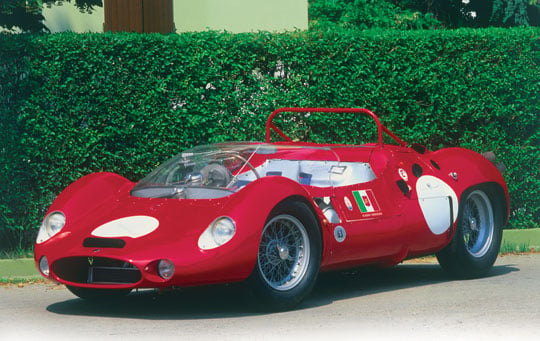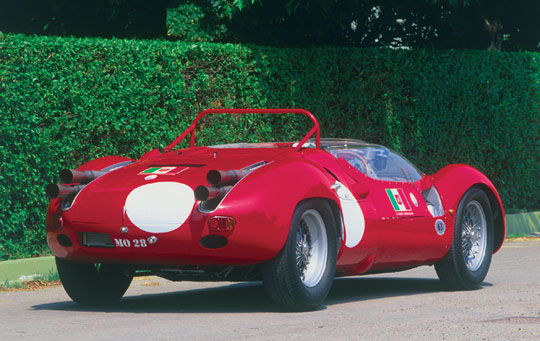
The following is an extract from Andy Heywood’s feature in Auto Italia magazine, February 2005. For access to the full feature, plus articles on the Ferrari 250GTO and 250LM on the Nordschleife, Michelotti's OSCA GT2, the Maserati 90th Anniversary celebrations and much more, see www.auto-italia.co.uk
Looking at this car today, it’s hard to believe that it spent the majority of its life on the scrapheap. Not just any scrapheap, of course, but the one that used to be a corner of the Maserati factory. A place where the discarded remains of failed experiments and superseded chassis numbers casually lay on top of each other, gathering dust.
At the time, no one could have foreseen their future importance or value and yet a succession of owners of the company did nothing to sweep them away for good. This probably says more about the general chaos that reigned in the Maserati racing department than about any conscious historical compassion – and it is that air of chaos that makes the stories of these cars, pre- and post-scrapheap, so enthralling. And none more so than the Tipo 63, the rear-engined Birdcage.
In late 1960, no doubt influenced by the Coopers of the time, Giulio Alfieri had an experimental rear-engined Birdcage built. Named in the Italian way ‘muletto’, or mule, this first version was initially given the rather vague chassis number 002. Featuring a similar four-cylinder engine to the 2.8-litre Tipo 61 and a rudimentary bare aluminium body, it first ran at the Modena Autodrome in December that year and was tested over the next few months by a whole host of visiting drivers such as Scarlatti, Moss and Trintignant. All concurred that the wheelbase was too short, which destroyed straight-line stability, a problem quickly addressed by lengthening the chassis. Critically though, this would still be known as the short-wheelbase version.
Once the specification had been decided, customer cars were built and sold but the factory retained the muletto. As in the front-engined cars, the four-cylinder engines produced tremendous torque, but at the expense of a low-speed vibration that had more than once literally shaken the car to pieces. Customer feedback suggested to Alfieri that while the torque advantage in short races or on twisty circuits was an overriding advantage, for long races such as Le Mans he should think again.
Alfieri had unfinished business with a V12 engine that he had originally designed for the 250F, and he did not hesitate in adapting it for use in the Birdcage. In March 1961, the muletto had its four-cylinder engine replaced by a 3.0-litre V12 and was sent to Le Mans in time for the customary April practice weekend.

By this time, Maserati had settled on the chassis numbering system for the rear-engined cars. The Tipo number 62 had gone to a V8 marine engine and therefore, in this contiguous series, the new series became Tipo 63. The first customer car was therefore 63.002 – crucially, not the same car as the muletto.
63.002 and the second example (63.004) were both four-cylinder cars and also present at the Le Mans test. Although all three cars were beset with mechanical problems, the V12 did prove to be the fastest. Now Maserati had a problem. In order to give its customers the best possible chance, a four-cylinder car was needed for short circuits and a V12 for longer races. At this point, although Maserati had made further examples of the Tipo 63, there were not enough cars to go round. One of Maserati’s customers was Count Volpi and his Scuderia Serenissima. Volpi had bought chassis 63.004 and also a new car, 63.008, which had been built with a long-wheelbase chassis, though still with a four-cylinder engine. 63.008 raced in the Targa Florio and at the Nürburgring 1000Km before, in theory, going to Le Mans in June. After the Nürburgring race, 63.008 ideally needed to be converted to V12 specification but, with only a two-week turnaround, this was not possible. Instead, Maserati sent the muletto, already a V12, masquerading under the chassis number 63.008.
Driven in the race by Nino Vaccarella and Ludovico Scarfiotti under the Serenissima banner, one journalist described the car as a ‘rough red banger with millions of holes cut in it’, not surprising for a factory test mule and, if any further proof were needed, the differences between the SWB muletto and LWB 63.008 were plain to see. Sadly, even after all this subterfuge, Vaccarella parked the car around 8.30pm after overheating had caused a head gasket to blow.
Once repaired, and now fitted with Alfieri’s new flexible de Dion rear suspension system in place of the earlier independent layout, there would be one more outing for the muletto, again as part of the Serenissima team. This time to the 4 Hours of Pescara in August, where again the long distance power of the V12 should have been an advantage. Frustratingly, after only one lap, Jo Bonnier was forced to retire with a broken driveshaft.
By now the season was drawing to a close and engineers and owners were looking ahead to 1962. The muletto had served its purpose and was retired, minus its V12 engine, to the scrapheap. Still wearing its Serenissima livery and chassis number 63.008, it was destined to stay there for 38 years.
In 1999, following the reorganisation of Maserati under Ferrari control, the final remnants of the past were sold off. The muletto remains were bought by the Panini family to add to their collection and a restoration has now been carried out by ex-Maserati mechanic Giancarlo Martinelli. Using a V12 from a later Tipo 64, the car continues to use its second identity of 63.008.
|
Words by Andy Heywood of Bill McGrath Maserati - www.classicmaseratis.co.uk, specialists in the restoration and preparation of classic and Biturbo era Maseratis - and pictures courtesy of Phil Ward and Auto Italia magazine.
See www.auto-italia.co.uk or call 01858 438817 for back issues and subscriptions. |
ClassicInside - The Classic Driver Newsletter
Free Subscription!



